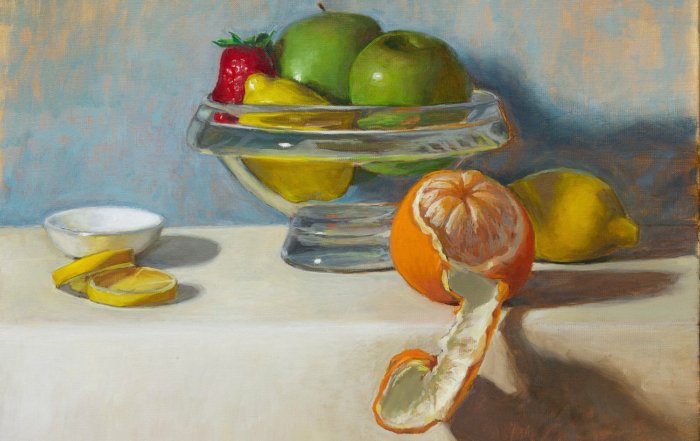Still Lives and the Maine Foodscape
EDIBLE MAINE
By Katy Keleher, Summer 2021
Prey Full-Time Painter, Part-Time Resident Captures the Color of Local Food.
Painter Barbara Ernst Prey showed her first work at the age of 9. It was a painting of an orange.
Artist- Barbara Prey
She was at an age when most would be displaying their art on refrigerator doors and classroom walls, but Prey’s bright little oil painting was selected for inclusion in an adult jury show. This was due, in part, to the influence of her mother, Peggy Ernst, who was an artist and head of the Design Department at New York City's Pratt Art Institute.
“We had a huge studio in my house, and I was always drawing, always painting,” says Prey, who now owns and operates a gallery in St. George, Maine. “On Saturdays, my mother would put on opera and set up a still life. … She was creative with them,” she recalls. “It wasn’t just SUMMER 2021 oranges, pears, and bananas. She would have different types of melons, bowls of onions—all these interesting colors.”
The exercises made Prey consider color, shape, and texture. When she wasn’t learning from her mother, she was walking through the Metropolitan Museum of Art, learning from the masters. She expanded her “visual vocabulary” and her language of colors from Cézanne, Van Gogh, Caravaggio, and Vermeer.
Decades later, Prey’s had an illustrious career in watercolors. Her clients have included President George Bush and first lady Barbara Bush, who commissioned her in 2003 to create a White House Christmas card, and NASA, which has hired Prey four times to create works for the Kennedy Space Center. Her pieces are housed at the National Gallery of Art, the Brooklyn Museum, and the Smithsonian American Art Museum. She’s exhibited at galleries around the globe, and her paintings are currently on display at the MASS MoCA in North Adams, Massachusetts. Tom Hanks has one of her lobster fishing boat scenes hanging in his home in Greece—a little sliver of the working Maine waterfront in the glamorous Mediterranean.
She’s not a Mainer, she knows, but the state has played a huge role in her life and work as she has been painting and exhibiting here for 40 years. Maine’s foodscape has been a great source of inspiration. Maine is where she comes to relax and where she comes to work, gathering ideas for paintings from the boats going out in the morning, the farmers weeding their fields at midday, and the evenings spent with friends in local restaurants. She’s more than a summer person, she says. Her ancestors settled in Maine hundreds of years ago. “I have a really long and deep-rooted connection to the state,” she says.
That includes deep reverence for the food system. Prey has gotten to know the families of Port Clyde, their stories and histories, as well as their hauls (the orange-shelled lobsters, the silvery fish). Sometimes, she paints them. “I’ve always known fishermen,” she says. “They come to my shows, and some of them are my friends.” On other occasions, she simply drives until she finds an inspirational Maine scene and will paint right there, on site. “I have a series of blueberry fields I’ve painted. I got a tick once, I’ll never forget that, from standing in the blueberry fields.” Still, it was worth braving the bloodsuckers: “The colors are so outstanding in the autumn. It’s incredibly rich, and there’s nothing like being there in person to observe the light.”
Prey has been cooped up during the pandemic, which has limited her ability to seek new Maine landscapes. She’s returned to still lives— though it’s more accurate to say she never truly left them. As a young artist, Prey landed a gig working for The New Yorker. That opened doors to other magazine work, including Gourmet magazine, where she depicted scenes both from the restaurant world and her own kitchen. She drew lobster, painted asparagus, and whimsically rendered dining rooms in watercolor. “Back when I was young and living in New York,” she remembers and laughs, “I didn’t have very much money, so I’d draw it and then eat it.”
When she wasn’t snacking on her still lives, Prey was observing, using the same careful eye she brought to the oil painting of an orange at age 9. In 2018, she sat down and painted another orange, placing it next to a vintage piece of Chinese blue-and-white porcelain. The halfpeeled fruit is a spot of warmth, a sunny orb that rests easily next to the classic colors of the tableware. “That was a night exercise,” she reveals. “Even in winter, I can always do still lives.” Cézanne, I suspect, would likely approve.
If you are interested in seeing more of Prey’s work, you can do so virtually or visit her gallery at 855 Main Street, Port Clyde, ME.
Read it on ediblemaine.com






